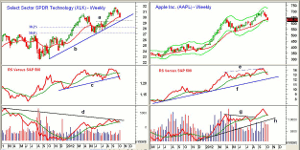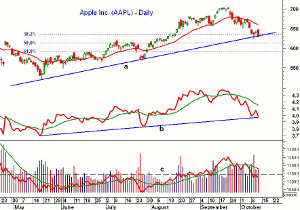As the technology sector and Apple continue to drop, MoneyShow’s Tom Aspray points out the seasonal and technical patterns that suggest investors should be looking to buy, not sell.
Stocks gave up most of their early gains on Thursday, which for the short term makes Friday’s close more important. The market internals were stronger than prices: on the NYSE, 63% of stocks advanced and only 32% declined.
The Nasdaq-100 has borne the brunt of the selling since the September highs, as it has declined 5.5%, versus just a 3.4% decline for the Spyder Trust (SPY). The Nasdaq-100 had outperformed the SPY since the June lows.
Of course, Apple (AAPL)—which makes up close to 20% of the technology heavy Nasdaq-100—has dropped even further. From the September highs, AAPL is down 11.6%...but one must remember that from the May lows to the recent highs, it had gained over 35%.
The bearish sentiment on AAPL is increasing, but those on the short side should be aware of Apple’s 30-year seasonal tendency to bottom in October. Does anyone really think Apple products won’t be on the top of most holiday buy lists?
Knowing this, is the recent correction unusual? In 2010 and 2011, AAPL corrected 15.8% and 14.8% respectively from its highs, before resuming its uptrend to close the year near its highs. Identifying key support for AAPL and the tech sector will allow investors to develop a sound buying strategy for this correction.
Chart Analysis: The Select Sector SPDR Technology (XLK) peaked at $31.74 in September, and has now corrected 5.7% from the highs. It is testing the 20-week EMA.
- The minor 50% Fibonacci retracement support is at $29.50, with the weekly chart support at $29.30 (line a).
- The rising 200-day MA is at $29, with further chart support in the $28.50 to $28.85 area.
- The weekly relative performance or RS analysis did confirm the recent highs, but has now dropped below its WMA and the uptrend (line c).
- The weekly on-balance volume is now just barely above its WMA, but is still below the longer-term downtrend (line d).
- There is short-term resistance now around $30.50 to $31.
- The daily studies are currently negative, but did not form any divergence at the September highs.
The weekly chart of Apple (AAPL) shows that it is also now testing its rising 20-week EMA, and is not far above its weekly Starc- band, which will be at $614.33 next week.
- The July highs are at $619, with more important support at $570, which was the July low.
- The relative performance did make new highs in September (line e), but has now dropped below its WMA.
- The RS line is still above the summer lows.
- The weekly on-balance volume (OBV) did make convincing new highs with prices, and is now testing its 21-week WMA.
- The OBV broke through resistance (line g) in the middle of August, signaling the latest rally.
- There is longer-term support for the OBV at the uptrend (line h).
- There is weekly resistance now in the $645 to $660 area.
NEXT: A Closer Look at Apple's Charts
|pagebreak|The daily chart of Apple (AAPL) shows that the uptrend (line a) from the May-June lows is being tested.
- The 50% Fibonacci retracement support is at $613.65, with the 61.8% support at $592.
- The daily relative performance did make marginal new highs in September, but dropped below its WMA on September 25.
- The RS line has now reached its uptrend (line b), and is well below its WMA. The daily RS analysis can turn around in just a few weeks.
- The daily OBV also confirmed the recent highs, but has now dropped below the breakout level from September.
- The selling has been heavy over the past few weeks, and I would expect the volume to decrease before the correction is over.
- The declining 20-day EMA is at $650, and a close above $672 is needed to suggest that the correction is over.
What it Means: As I noted recently in “October's Top Seasonal Sectors,” technology is one of the sectors that has a strong seasonal trend to bottom in October.
It is important that the technical studies be used in conjunction with the seasonal trends. The weekly and monthly analysis for both Apple (AAPL) and the Select Sector SPDR Technology (XLK) are positive, while the daily studies are currently negative.
Especially for AAPL, determining good risk-reward buy levels is the best strategy, as it can move away from support very quickly
For those not already long either Apple (AAPL) or the Select Sector SPDR Technology (XLK), I would suggest looking to buy on this correction.
How to Profit: For Select Sector SPDR Technology (XLK), go 50% long at $29.46 and 50% at $29.04, with a stop at $28.44 (risk of approx. 2.7%).
For Apple (AAPL), go 50% long at $614.72 and 50% long at $603.44, with a stop at $567.82 (risk of approx.6.8%). On longs, raise the stop to $596.66 on a move above $663.Portfolio Update: Longs in Apple (AAPL) from $567.88 was stopped out at $633.79, as I did not expect such a rapid decline without daily negative divergences.
Investors should still be long Select Sector SPDR Technology (XLK) from $28.18. We sold half at $31.54. Going forward, use a slightly wider stop at $28.44.




















